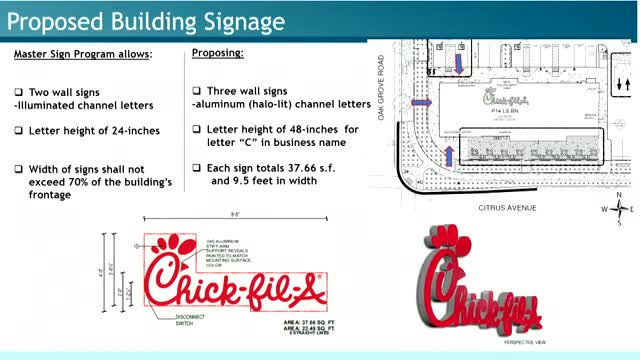Chick Fil A signage proposal sparks neighborhood controversy
August 08, 2024 | Walnut Creek City, Contra Costa County, California

This article was created by AI summarizing key points discussed. AI makes mistakes, so for full details and context, please refer to the video of the full meeting. Please report any errors so we can fix them. Report an error »

In a recent government meeting, discussions centered around the proposed signage for a new Chick-fil-A location, highlighting both community concerns and regulatory considerations. The Design Review Commission (DRC) approved two illuminated wall signs, each featuring channel letters with a height of 24 inches. However, the proposal for a third sign, which included a prominent 48-inch logo, faced opposition from local residents who argued that it would create visual blight and excessive advertising at the entrance to their neighborhood.
Despite these objections, the DRC defended its decision, stating that the larger logo would not overpower the building's facade, which spans 123 feet on the north and south elevations. The DRC noted that similar letter heights have been approved in nearby Walnut Creek, where logos have ranged from 36 to 60 inches tall, provided they maintain architectural harmony with the building's scale.
The applicant's appeal for the third sign was based on the argument that it would enhance visibility from multiple street frontages, a consideration supported by the city’s sign ordinance, which allows for one sign per frontage for buildings with multiple street access. The proposed signs would total 28.5 feet in width, well within the 70% limit of the building's frontage as outlined in the master sign program.
As the meeting concluded, the discussions underscored the ongoing balancing act between business interests and community aesthetics, with the final decision on the signage still pending further review.
Despite these objections, the DRC defended its decision, stating that the larger logo would not overpower the building's facade, which spans 123 feet on the north and south elevations. The DRC noted that similar letter heights have been approved in nearby Walnut Creek, where logos have ranged from 36 to 60 inches tall, provided they maintain architectural harmony with the building's scale.
The applicant's appeal for the third sign was based on the argument that it would enhance visibility from multiple street frontages, a consideration supported by the city’s sign ordinance, which allows for one sign per frontage for buildings with multiple street access. The proposed signs would total 28.5 feet in width, well within the 70% limit of the building's frontage as outlined in the master sign program.
As the meeting concluded, the discussions underscored the ongoing balancing act between business interests and community aesthetics, with the final decision on the signage still pending further review.
View full meeting
This article is based on a recent meeting—watch the full video and explore the complete transcript for deeper insights into the discussion.
View full meeting
